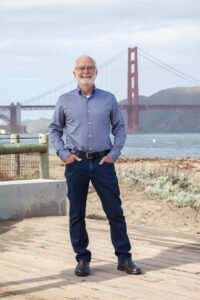Summary
The Oral History Center is excited to announce the release of Greg Moore's oral history. Moore served as the executive director the Golden Gate National Parks Conservancy from 1986 until his retirement in 2019.
The San Francisco Bay Area is known for the kind of environmental advocacy that has become a model for regions around the country. There’s a long legacy, spanning decades, of people behind this work. Greg Moore is one of these people. Greg has dedicated his career to conserving public lands and making parks accessible for all. He, too, has become a model, someone to whom people throughout the country – and world – look for guidance.

Greg served as the executive director of the Golden Gate National Parks Conservancy from 1986 until his retirement in 2019. The GGNPC was founded in 1981 and its mission is to preserve the Golden Gate national parks, enhance the park visitor experience, and build a community dedicated to conserving the parks for the future. But his work in the environmental sector began long before 1986, dating back to his time as a student at UC Berkeley in the newly-formed Conservation of Natural Resources School and College of Environmental Design, during the environmental decade of the 1970s when the Environmental Protection Agency was formed and regulatory laws, like the Clean Water Act, were passed. And even before that, when he was a ranger with the National Park Service.
I had the privilege of sitting down with Greg in 2022 to interview him about his life and work. In preparation for the sixteen hours I would end up spending with him, I spoke with a number of people who know him in different capacities – former fellow National Park Service rangers; as well as Conservancy board members, employees, and donors. One thing was clear: Greg is universally respected for his work and his collegiality. I kept hearing about how, as both a colleague and manager, he listened to people and carefully considered their perspectives. About how, as the executive director of the Conservancy, he wrote heartfelt letters to board members each year, letters that they all not only save, but cherish. About how he would write and perform in an annual musical parodying popular songs for year-end parties.
But what struck me the most was how present Greg was during each phase of our interview sessions. Whether we were discussing how he developed a love for music as a child; his studies at Cal and then later at the University of Washington; meeting his wife, Nancy, and raising their son; or his love for parks; the development of his career; managing a large staff and multi-million dollar fundraising campaigns; and working to make parks accessible for all, Greg took every question I asked seriously, responding sincerely and weaving in humor throughout.
Greg is perhaps best known for his work with the Conservancy. He played a role in the creation of the organization, which he discussed in more detail in his oral history, before becoming the executive director. There are an incredible array of projects on which he worked during his tenure with the Conservancy, like various habitat restorations, converting the Presidio from an Army base to a park, transiting Fort Baker from a military base into a national park, promoting citizen science through the Golden Gate Raptor Observatory, transforming Crissy Field into one of San Francisco’s crown jewels and creating the beloved Crissy Field Visitor Center, developing community partnerships and youth programs, and shepherding the Tunnel Tops project into existence. The list goes on.
The underlying theme of each of these projects was the drive to make parks accessible for everyone. “Parks for All” is the beating heart of the Conservancy’s mission. Here’s what Greg said about the origin of the mission:
“The ‘Parks For All’ came when the Conservancy was trying to think through how to simply and straightforwardly describe our mission. The Conservancy had a mission statement, but like many it was probably twenty-five to thirty words long, and I began thinking about how to put that in simple words that were very direct and, in some way, have the power-of-three impact. That’s when I began thinking, Well, of course, we’re about ‘parks.’ These are the physical places that we need to transform and enhance. Then we’re about ‘for all’ because these places are owned by every person in the United States as national parks, and then our final responsibility is ‘forever’ – to pass them from one generation to the next. It not only summarized our mission but almost described a theory of change that first you have the places and to make them for all youth to improve and enhance them. You have an opportunity to engage people in their enjoyment, in their stewardship, in their contributions for all, and then finally all the restoration work that cares for these places that you’ve enhanced and taken care of.”
Greg wanted to make sure people were aware that the parks existed, they felt comfortable there, and that they were relevant to the visitor’s life experience. He did this by bringing communities into planning conversations, implementing a bus route that would drive people from their neighborhoods to the parks and then back again, partnering with public libraries, and creating a multitude of programs – for kids, related to art, and citizen science for civilian park goers. Greg’s commitment to the Conservancy’s simple mission is what made the organization so successful and such an integral part of life in the Bay Area. And Greg’s interest in working with communities and listening to people – his colleagues, board members, donors, and park users alike – is what has made him such a towering figure in the Bay Area’s environmental movement.
It is with great excitement that we announce Greg Moore’s oral history is now publicly available.